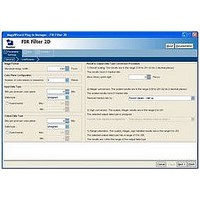IPSR-VIDEO Altera, IPSR-VIDEO Datasheet - Page 134

IPSR-VIDEO
Manufacturer Part Number
IPSR-VIDEO
Description
RENEWAL Of IPS-VIDEO
Manufacturer
Altera
Series
IP Suitesr
Datasheet
1.IPS-VIDEO.pdf
(202 pages)
Specifications of IPSR-VIDEO
Software Application
IP CORE, SUITES
Supported Families
Arria GX, Cyclone II, HardCopy II, Stratix II
Features
Common Avalon Streaming (Avalon-St) Interface And Avalon-St Video Protocol
Core Architecture
FPGA
Core Sub-architecture
Arria, Cyclone, Stratix
Rohs Compliant
NA
Lead Free Status / RoHS Status
na
- Current page: 134 of 202
- Download datasheet (6Mb)
5–54
Video and Image Processing Suite User Guide
Nearest Neighbor Algorithm
Bilinear Algorithm
In the formal definitions of the scaling algorithms, the width and height of the input
image are denoted w
are denoted w
point on the input image and O is the function that returns an intensity value on the
output image.
The nearest-neighbor algorithm that the scaler uses is the lowest quality method, and
uses the fewest resources. Jagged edges may be visible in the output image as no
blending takes place. However, this algorithm requires no DSP blocks, and uses fewer
logic elements than the other methods.
Scaling down requires no on-chip memory; scaling up requires one line buffer of the
same size as one line from the clipped input image, taking account of the number of
color planes being processed. For example, up scaling an image which is 100 pixels
wide and uses 8-bit data with 3 colors in sequence but is clipped at 80 pixels wide,
needs 8 × 3 × 80 = 1920 bits of memory. Similarly, if the 3 color planes are in parallel,
the memory requirement is still 1920 bits.
For each output pixel, the nearest-neighbor method picks the value of the nearest
input pixel to the correct input position. Formally, to find a value for an output pixel
located at (i, j), the nearest-neighbor method picks the value of the nearest input pixel
to ((i+0.5) w
The 0.5 values in this equation come from considering the coordinates of an image
array to be on the lines of a 2D grid, but the pixels to be equally spaced between the
grid lines that is, at half values.
This equation gives an answer relative to the mid-point of the input pixel and 0.5
should be subtracted to translate from pixel positions to grid positions. However, this
0.5 would then be added again so that later truncation performs rounding to the
nearest integer. Therefore no change is needed. The calculation performed by the
scaler is equivalent to the following integer calculation:
The bilinear algorithm that the scaler uses is higher quality and more expensive than
the nearest-neighbor algorithm. The jaggedness of the nearest-neighbor method is
smoothed out, but at the expense of losing some sharpness on edges.
Resource Usage
The bilinear algorithm uses four multipliers per channel in parallel. The size of each
multiplier is either the sum of the horizontal and vertical fraction bits plus two, or the
input data bit width, whichever is greater. For example, with four horizontal fraction
bits, three vertical fraction bits, and eight-bit input data, the multipliers are nine-bit.
With the same configuration but 10-bit input data, the multipliers are 10-bit. The
function uses two line buffers. As in nearest-neighbor mode, each of line buffers is the
size of a clipped line from the input image. The logic area is more than the nearest-
neighbor method.
O(i, j) = F((2 × w
in
/w
out
out
and h
, (j+0.5) h
in
in
× i + w
out
and h
. F is the function that returns an intensity value for a given
in
in
in
/h
)/(2 × w
respectively. The width and height of the output image
out
).
out
), (2 × h
in
× j + h
in
)/(2 × h
Chapter 5: Functional Descriptions
January 2011 Altera Corporation
out
))
Scaler
Related parts for IPSR-VIDEO
Image
Part Number
Description
Manufacturer
Datasheet
Request
R

Part Number:
Description:
CYCLONE II STARTER KIT EP2C20N
Manufacturer:
Altera
Datasheet:

Part Number:
Description:
CPLD, EP610 Family, ECMOS Process, 300 Gates, 16 Macro Cells, 16 Reg., 16 User I/Os, 5V Supply, 35 Speed Grade, 24DIP
Manufacturer:
Altera Corporation
Datasheet:

Part Number:
Description:
CPLD, EP610 Family, ECMOS Process, 300 Gates, 16 Macro Cells, 16 Reg., 16 User I/Os, 5V Supply, 15 Speed Grade, 24DIP
Manufacturer:
Altera Corporation
Datasheet:

Part Number:
Description:
Manufacturer:
Altera Corporation
Datasheet:

Part Number:
Description:
CPLD, EP610 Family, ECMOS Process, 300 Gates, 16 Macro Cells, 16 Reg., 16 User I/Os, 5V Supply, 30 Speed Grade, 24DIP
Manufacturer:
Altera Corporation
Datasheet:

Part Number:
Description:
High-performance, low-power erasable programmable logic devices with 8 macrocells, 10ns
Manufacturer:
Altera Corporation
Datasheet:

Part Number:
Description:
High-performance, low-power erasable programmable logic devices with 8 macrocells, 7ns
Manufacturer:
Altera Corporation
Datasheet:

Part Number:
Description:
Classic EPLD
Manufacturer:
Altera Corporation
Datasheet:

Part Number:
Description:
High-performance, low-power erasable programmable logic devices with 8 macrocells, 10ns
Manufacturer:
Altera Corporation
Datasheet:

Part Number:
Description:
Manufacturer:
Altera Corporation
Datasheet:

Part Number:
Description:
Manufacturer:
Altera Corporation
Datasheet:











